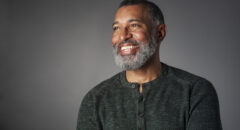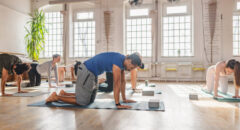
Roller skating is Randy Lewis Jr's way of life. On his windowsill, an old skate now serves as a flowerpot. There are stuffed skates hanging from the ceiling in his living room and skate ornaments nestled into a small plant by the door. The memorabilia is in his kitchen, his bathroom, everywhere in the house. This is more than a personal hobby—he has a quad skate tattooed on his right forearm, Lewis is part of a thriving underground community of roller skaters. There really isn't a name for what Lewis and his friends do on skates—every city has its own style. It's part dance, set to a rhythm, but still different from anything most Americans have seen.
MUST READ: Baltimore Police Officers Indicted in Freddie Gray's Death
There are hundreds of skaters in Baltimore, says Lewis. It's a proud community. And so as the media continued to portray Baltimore as a city of thugs, the only way Lewis knew to reshape that image was to get out and roller skate.
On Tuesday afternoon, despite his mother's pleas, Lewis grabbed his pair of well-worn outdoor skates, and set out towards the protests. He met about 15 friends at Shake & Bake on Pennsylvania Ave, the only remaining skating rink within the Baltimore city limits. Lewis' friend Travis Johnson joined him. Johnson grew up in the city but recently moved out to the suburbs.
"Personally for me just sitting at home looking at everything I felt uneasy," says Johnson. "Just being so removed, seeing it on TV, unfolding right in my city, I wanted to at least be down there to understand what is going on personally."

"People had been saying this is like a war zone. It's not a war zone, and we wanted to......counteract that with skating," says Johnson. "This was a peaceful way to say let's get back on the saddle and get something accomplished."
As they skated up the street, people started yelling, "Roll, bounce, roll bounce." About 25 local gang members walked alongside, cheering them on; a marching band gave them a beat. Drum circles, dancers, and other peaceful demonstrators joined in. People were asking skaters to stop for photos. At the intersection of Pennsylvania and North Avenues, a circle started to form around them. Black, white, young, old, it was a completely mixed bag. "It was beautiful," says Johnson. "It was more reflective of the tone of the city.
"People are not paying attention to a gun over here if you're cheering and dancing and having fun," he adds. It was joyous.
But the next day, the Baltimore Post called it a "street party," totally missing the entire point.
"Parties have no purpose at all," Johnson says. "It was about the message of unity, it was, 'Okay, this city is united in trying to find the silver lining of the whole situation.'
Roll on Baltimore skaters, roll on. We see you and we love you.
For more stories like this, be sure to click here.









